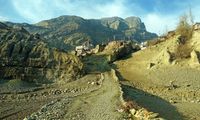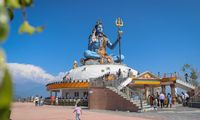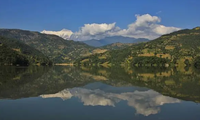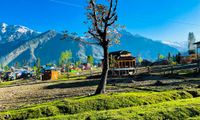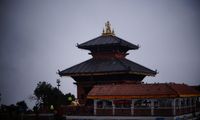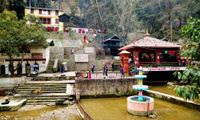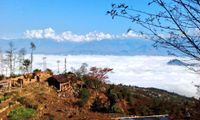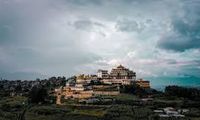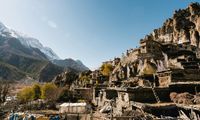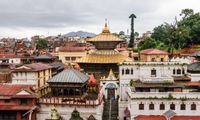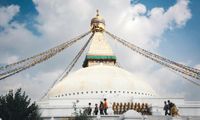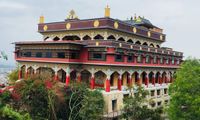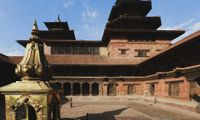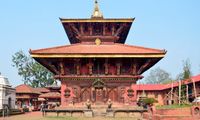Swargadwari Pyuthan Temple

About
Swargadwari Temple, located in Pyuthan, Nepal, is a revered Hindu pilgrimage site known for its spiritual significance and panoramic views. Surrounded by nature, it offers a peaceful retreat for devotees and trekkers alike. The temple is associated with Guru Maharaj and is believed to be a divine gateway to heaven, attracting visitors year-round.
Locate Us
Swargadwari Temple, situated in the serene hills of Pyuthan District, Lumbini Province, Nepal, is a revered Hindu pilgrimage site known as the “Gateway to Heaven.” The name "Swargadwari" translates to "doorway to heaven," and the temple holds deep religious significance among devotees, as it is believed to be the site where the Pandavas from the Mahabharata ascended to heaven.
Locate Us
Swargadwari Temple is a revered Hindu pilgrimage site located in the hills of Pyuthan District, Lumbini Province, Nepal. Situated at an elevation of about 2,100 meters, the temple offers breathtaking panoramic views of the Himalayan peaks, including Dhaulagiri, Annapurna, and Machhapuchhre. Visitors can reach the temple via two main routes: one from Butwal through Bhalubang and Bhingri, involving a jeep or a trek of about 13 kilometers, and another from Butwal through Ghorahi and Dharampani, followed by a short uphill walk. The temple is famous for its eternal fire ritual, which has been burning continuously since 1895, and its large cow shelter, reflecting the site's deep spiritual and cultural significance. Travelers are advised to prepare for rugged road conditions and changing weather, especially during the monsoon season. Swargadwari is not only a place of worship but also a destination that offers a rich blend of natural beauty, spirituality, and local culture.
- Via Bhalubang → Bhingri → Swargadwari: This route covers Butwal, Bhalubang, and Bhingri after leaving Kathmandu. The 13-kilometer drive from Bhingri to the temple may be made on foot or by jeep.
- By way of Ghorahi → Dharampani → Swargadwari: It is also possible to get from Kathmandu via Butwal, then to Ghorahi, and finally to Dharampani. The temple is only a short 1.5-kilometer walk from Dharampani.
Historical Background of Swargadwari Temple
Swargadwari Temple, located atop a scenic hill in Pyuthan district of western Nepal, is one of the most sacred Hindu pilgrimage sites in the country. The temple’s name, Swargadwari, means “Gateway to Heaven,” and it holds deep mythological and spiritual significance for followers of Hinduism.
Connection to the Pandavas
According to legend, the site of Swargadwari is believed to be the very place where the Pandavas, heroes of the Mahabharata, meditated and performed Yajnas (fire rituals) before ascending to heaven. This belief has given the site a divine status, making it a revered spot for those seeking moksha (spiritual liberation).
Establishment by Guru Maharaj Narayan Khatri
In the late 19th century (around 1941 B.S./1884 A.D.), a spiritually enlightened sage known as Guru Maharaj Narayan Khatri arrived at this site. He was believed to possess divine powers and had a deep knowledge of Vedic rituals and spiritual healing. Guru Maharaj began performing Agni Yajnas (sacred fire offerings) and established the Akhand Dhuni – an eternal flame that continues to burn to this day. He also built a Guthighar (cow shelter) to protect and worship cows, which are considered holy in Hinduism. Under his guidance, the temple complex expanded, and his teachings began attracting devotees from all over Nepal and India.
Religious Significance of Swargadwari Temple
Swargadwari Temple holds deep spiritual and religious significance among Hindus in Nepal and beyond. The name Swargadwari literally means "Gateway to Heaven." According to Hindu mythology and local belief, it is said that the Pandavas from the Mahabharata offered holy fire rituals here and ascended to heaven from this very place. This legend gives the temple a sacred status as a divine pilgrimage site.
The temple is also associated with Guru Maharaj Narayan Khatri, a spiritual leader who meditated and conducted Agni Yajnas (sacred fire rituals) in the late 19th century. He established a spiritual community, built the cow shelter (Guthighar), and started the eternal fire (Akhand Dhuni), which still burns today, symbolizing uninterrupted devotion and purity.
Rituals and Practices at Swargadwari Temple
Swargadwari Temple is not only a sacred pilgrimage site but also a vibrant center of daily and seasonal Hindu rituals. The spiritual energy of the temple is maintained through traditional Vedic practices, which have been ongoing since the late 19th century.
1. Akhand Dhuni (Eternal Fire)
- The eternal fire has been burning continuously since the time of Guru Maharaj Narayan Khatri.
- Devotees believe this fire carries divine power and blessings.
- It is tended by temple priests who offer logs and herbs daily as part of a havan ritual.
2. Daily Pujas and Aarti
- Priests perform morning and evening pujas (prayer offerings) using Vedic mantras, incense, and flowers.
- Aarti, a devotional ritual with oil lamps, is performed to honor the deities and the sacred fire.
- Devotees actively participate in the chants and offerings during these times.
3. Cow Worship (Gau Puja)
- Cows are considered holy in Hinduism and are deeply respected at Swargadwari.
- The temple maintains a large gaushala (cow shelter).
- Devotees feed and care for the cows as a form of seva (selfless service).
Festivals Celebrated at Swargadwari Temple
Swargadwari Temple in Pyuthan, Nepal, is a revered Hindu pilgrimage site, and several important festivals are celebrated here with deep spiritual devotion and communal participation. These festivals attract thousands of pilgrims from across Nepal and India who come to seek blessings, offer prayers, and participate in sacred rituals.
1. Baisakh Purnima (Buddha Jayanti)
- Time: Full moon day of Baisakh (April–May)
- Devotees gather to participate in large-scale fire rituals (yajnas), sing bhajans, and stay overnight on the sacred hill.
- It marks a time of spiritual renewal, and many people walk barefoot for miles to reach the temple.
2. Marga Sukla Purnima (Swargadwari Mela)
- Time: Full moon of Marga month (November–December)
- Significance: Commemorates the arrival of Guru Maharaj Narayan Khatri, the founder of the temple.
- Devotees honor the Guru's memory through special prayers, ritual fire offerings, and community meals (bhandaara).
- Cows are worshipped, and people offer grass, grain, and ghee to support the gaushala (cow shelter).
3. Ekadashi and Purnima Observances
- Twice a month: Ekadashi (11th lunar day) and Purnima (full moon)
- Regular fasting, prayers, and small fire pujas are held by resident priests and pilgrims.
- Devotees also bring offerings like grains, ghee, wood, and cash.
4. Guru Maharaj Remembrance Day
- A special day (based on the lunar calendar) is marked in honor of Guru Maharaj's spiritual departure.
- A symbolic fire ceremony is held, and teachings of Guru Maharaj are read aloud.
Facilities and Services at Swargadwari Temple
Swargadwari Temple in Pyuthan is not only a spiritual destination but also a well-managed pilgrimage site that offers basic yet essential facilities for visitors. Despite its remote hilltop location, the temple authorities and local communities work together to ensure that pilgrims have a peaceful and manageable stay.
1. Community Kitchen (Bhandaara)
- A free or low-cost kitchen serves vegetarian meals to devotees.
- Meals typically include rice, lentils, vegetables, and pickles.
- Sponsored meals (bhandaara) are often provided during festivals or by devotees as an offering.
2. Drinking Water & Sanitation
- Clean drinking water taps are available near the lodging and temple premises.
- Toilets and washing areas are maintained for basic hygiene, though facilities are simple due to the location.
3. Prayer and Meditation Areas
- Designated spaces near the Akhand Dhuni (eternal fire) for prayer and meditation.
- Calm, natural surroundings make it ideal for spiritual reflection.
Tourism and Pilgrimage Experience at Swargadwari Temple
Swargadwari Temple in Pyuthan, Nepal, is more than just a religious destination—it's a journey of spiritual awakening, natural beauty, and cultural immersion. Whether you're a devout Hindu pilgrim or a curious traveler seeking peace and adventure, Swargadwari offers a truly unique experience.
1. Trekking and Nature
- Scenic Trail: The journey to Swargadwari involves a scenic uphill trek through lush forests, hills, and remote villages.
- Biodiversity: The region is home to diverse flora and fauna, offering a peaceful escape from city life.
- Panoramic Views: From the temple hilltop, visitors enjoy stunning views of the Rolpa and Pyuthan hills and the mid-western Himalayas on clear days.
2. A Sacred Pilgrimage
- Spiritual Significance: Believed to be connected to the Pandavas and founded by the revered Guru Maharaj, Swargadwari is a holy gateway to heaven.
- Pilgrimage Tradition: Devotees walk or ride for hours through rugged terrain to reach the temple, often barefoot, chanting and carrying offerings.
- Ritual Participation: Visitors take part in fire rituals (yajnas), aarti, cow worship, and spend time meditating near the eternal fire
3. A Blend of Culture and Devotion
- Along the way, travelers pass through Magar and Chhetri villages, getting glimpses of rural Nepali life.
- Volunteering opportunities in cooking, cleaning, or cow feeding allow pilgrims to engage in acts of service (seva).
- The journey promotes values of faith, humility, and simplicity.
Conclusion
Swargadwari Temple stands as a timeless symbol of Nepal’s rich spiritual heritage and devotion. Perched high in the hills of Pyuthan, it offers not just a religious destination, but a deeply moving journey of faith, sacrifice, and inner peace. Rooted in ancient legends and sustained by daily rituals and community devotion, the temple continues to inspire thousands of pilgrims every year. Whether you're drawn by the sacred fire, the stories of the Pandavas, or the serene mountain atmosphere, Swargadwari promises a rare blend of spiritual enlightenment, natural beauty, and cultural depth. It is truly a gateway—both to heaven and to the heart of Nepalese tradition.
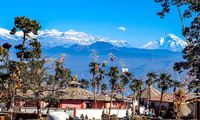





.jpg)











